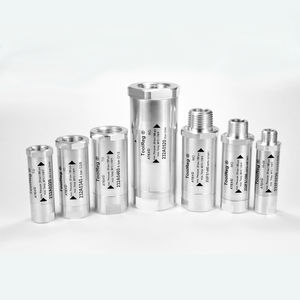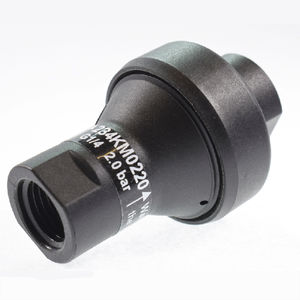
- Hydraulics - Pneumatics
- Valve
- Compressed air pressure regulator
- Protect-Air - a brand of TRI-MATIC
- Company
- Products
- Catalogs
- News & Trends
- Exhibitions
Compressed air pressure regulator SaveAir®membranesingle-stagepneumatic

Add to favorites
Compare this product
Characteristics
- Product
- for compressed air
- Technology
- membrane
- Number of stages
- single-stage
- Applications
- pneumatic
- Other characteristics
- miniature
- Pressure
18 bar
(261.07 psi)- Flow
400 l/min, 600 l/min, 700 l/min, 800 l/min
(105.67 us gal/min, 158.5 us gal/min, 184.92 us gal/min, 211.34 us gal/min)
Description
The SaveAir® regulator is an independent membrane regulator that can be installed in every compressed air system. It supplies a constant, exact outlet pressure regardless of the input pressure. The pressure is factory-set and cannot be changed.
SaveAir prevents dynamic pressure waste. This arises when the pressure and throughput at the withdrawal point are unnecessarily higher than those specified by the manufacturer to achieve the desired function. Dynamic pressure waste is extremely costly, a waste of energy that may be found throughout industry.
Dynamic pressure waste is found throughout the industry and the SaveAir® is the right solution to tackle unwanted costs, which arise when the specified pressure and flow at the withdrawal point is higher than specified by the manufacturer. The SaveAir® can be set to those specifications and help save a lot of money.
Advantages
• Supplies tools exclusively with the specified pressure
• No pressure gauge needed
• Prevents compressed air waste
• Saves energy – reduces costs
• Highly reliable
• Locked to prevent pressure change – tamper proof
• Small and compact
• Increases tool service life
Applications
• Piping and compressed air systems
• Compressed air used in automation for actuation
• Control, feeding or transportation
• Pick and place units in automatic assembly systems
Catalogs
SaveAIr
2 Pages
HoseGuard®
3 Pages
Other Protect-Air - a brand of TRI-MATIC products
In-line Air Regulators - SaveAir® / ToolReg® / CartReg® and OxyReg
Related Searches
- Pressure limiter
- Single-stage regulator
- Diaphragm pressure regulator
- Metal pressure regulator
- Compressed air regulator
- Stainless steel pressure regulator
- Compact pressure regulator
- Inert gase pressure regulator
- Pneumatic pressure regulator
- Oxygen regulator
- Piston regulator
- Line pressure regulator
- Miniature pressure regulator
- Pressure regulator and reducer
- Water pressure regulator
- Pressure regulator for medical applications
- Analytical instrument pressure regulator
- Air and gas pressure regulator and reducer
- Rugged pressure regulator
- Corrosion-resistant pressure regulator
*Prices are pre-tax. They exclude delivery charges and customs duties and do not include additional charges for installation or activation options. Prices are indicative only and may vary by country, with changes to the cost of raw materials and exchange rates.






